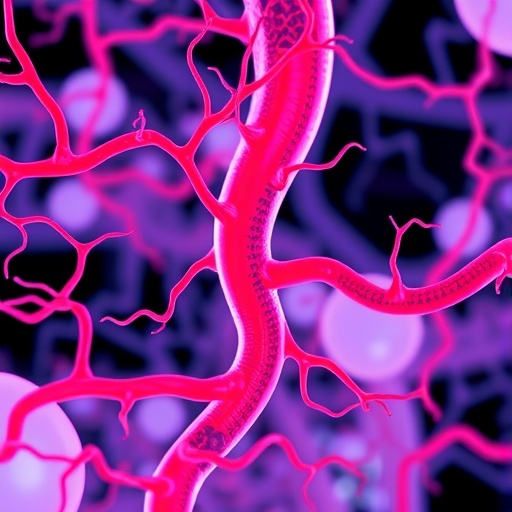Emerging research in the realm of biomedicine is forging a new path in the field of vascular tissue engineering. The significance of understanding the interplay between patient variability and Notch signaling during the in situ vascular tissue engineering process has been comprehensively analyzed in a recent study. The work, led by researchers van Asten, Sahlgren, and Humphrey, explores the nuanced dynamics of cellular interactions that occur during tissue engineering interventions, a pivotal area of inquiry that could reshape therapeutic strategies for vascular repair and regeneration.
At the heart of this innovative research lies Notch signaling, a crucial pathway involved in cell communication. This intricate signaling cascade plays a vital role in the regulation of vascular development and homeostasis. Notch signaling exhibits a variety of functions, from regulating cell fate to maintaining the stability of the vascular system. Understanding how this signaling mechanism influences vascular tissue engineering could unveil new methods for enhancing the restoration of vascular structures in patients, thus driving forward the field of regenerative medicine.
Notably, the study emphasizes how patient variability can significantly affect the outcomes of vascular tissue engineering. Each patient’s unique biological makeup—such as genetic predispositions, age, sex, and underlying health conditions—contributes to different responses to therapeutic interventions. These variances pose significant challenges for clinicians and researchers seeking to develop standardized approaches to tissue engineering. By examining the effects of these individual differences, the researchers aim to tailor interventions that account for this biological diversity, thereby optimizing treatment efficacy.
Moreover, the researchers conducted extensive simulations to model the effects of various patient profiles on the behavior of vascular networks engineered in situ. Through computational methods, they were able to predict how alterations in Notch signaling might yield different outcomes based on specific patient characteristics. The results of these simulations are expected to guide future experimental studies, setting the stage for a more personalized approach to vascular repair.
A further aspect of the research delves into the integration of biomaterials conducive to Notch signaling. The specific selection and modification of biomaterials could dictate the activation of this signaling pathway, ultimately influencing tissue formation. This critical finding suggests that the design of scaffolds used in vascular engineering should not only consider mechanical properties but also the biochemical signals that will engage cellular pathways crucial for successful tissue integration and healing.
The implications of such findings extend beyond basic scientific inquiry; they represent a paradigm shift in the way vascular injuries and diseases might be addressed in clinical settings. By embracing a more holistic understanding of biological variability and signaling pathways, medical practitioners could vastly improve the success rates of tissue engineering procedures aimed at repairing or reconstructing damaged vascular tissues.
Additionally, the collaboration between computational modeling and experimental validation represents a significant methodological advancement in the field. Traditional tissue engineering has often relied on empirical approaches; however, the integration of predictive models allows for a more comprehensive understanding of complex biological systems. This transition not only enhances the reliability of research findings but also accelerates the development and testing of novel therapeutic strategies.
The future of vascular tissue engineering appears promising, especially with the ongoing advancements in understanding the multifaceted roles of Notch signaling and patient variability. The challenge moving forward will be to continue bridging the gap between basic science and clinical application, ensuring that these exciting discoveries translate into real-world medical solutions.
As the body of knowledge grows, researchers are urged to collaborate across disciplines, combining insights from genetics, bioengineering, and clinical practice. Such collaborative efforts could lead to innovations that further refine the engineering of vascular tissues, ultimately improving patient outcomes and enhancing the quality of life for individuals suffering from vascular diseases.
As these researchers move forward, they emphasize the importance of continuous exploration and validation of these models. Ongoing studies will likely refine our understanding of the mechanisms at play and how they can be manipulated to achieve desired outcomes in vascular tissue engineering. By embracing a future-forward perspective that encompasses patient-individualized treatments, the research community stands on the brink of groundbreaking developments in regenerative medicine.
In a world where chronic diseases and vascular injuries are prevalent, the pursuit of cutting-edge solutions like tailored vascular tissue engineering could pave the way for breakthroughs that revolutionize treatment paradigms. With ongoing investigations into Notch signaling and its implications for patient variability, the scientific community remains optimistic about the transformative potential of these findings in the field of biomedicine.
As this study indicates, the future of healthcare will undoubtedly require an integrated approach that harmonizes technological innovation with biological insight. The endeavor to unearth the mysteries of cellular signaling and patient individuality will continue to shape the landscape of not just vascular tissue engineering, but medicine as a whole.
Subject of Research: The interplay between patient variability and Notch signaling in in situ vascular tissue engineering.
Article Title: Predicted Effects of Patient Variability and Notch Signaling on In Situ Vascular Tissue Engineering.
Article References:
van Asten, J.G.M., Sahlgren, C.M., Humphrey, J.D. et al. Predicted Effects of Patient Variability and Notch Signaling on In Situ Vascular Tissue Engineering.Ann Biomed Eng (2025). https://doi.org/10.1007/s10439-025-03843-7
Image Credits: AI Generated
DOI: https://doi.org/10.1007/s10439-025-03843-7
Keywords: Vascular Tissue Engineering, Notch Signaling, Patient Variability, Regenerative Medicine, Biomedicine.




